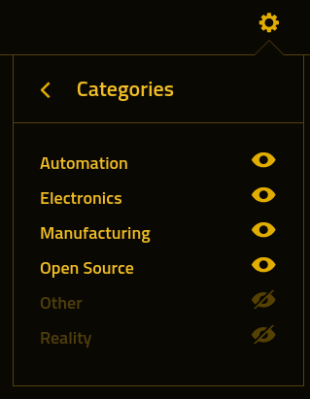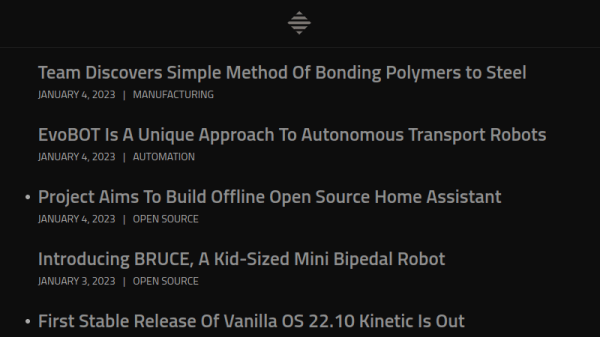Within the world of medical science fiction they are found everywhere: tiny robots that can zip through blood vessels and intestines, where they can deliver medication, diagnose medical conditions and even directly provide treatment. Although much of this is still firmly in the realm of science-fiction, researchers at Stanford published work last year on an origami-based type of robots, controlled using an external magnetic field. Details can be found in the Nature Communications paper. Continue reading “Tiny Robots That Bring Targeted Drug Delivery And Treatment A Little Bit Closer”
News3613 Articles
This Week In Security: Lastpass Takeaway, Bitcoin Loss, And PyTorch
We mentioned the LastPass story in closing a couple weeks ago, but details were still a bit scarce. The hope was that LastPass would release more transparent information about what happened, and how many accounts were accessed. Unfortunately it looks like the December 22nd news release is all we’re going to get. For LastPass users, it’s time to make some decisions.
To recap, an attacker used information from the August 2022 breach to target a LastPass Employee with a social engineering ploy. This succeeded, and the attacker managed to access LastPass backups, specifically a customer account database and customer vaults. There has been no official word of how many users’ data were included, but the indication is that it was the entire dataset. And to make matters worse, the encrypted vault is only partially encrypted. Saved URLs were exposed as plain-text to the attacker, though usernames and passwords are still encrypted using your master password.
So what should a LastPass user do now? It depends. We can assume that whoever has the LastPass vault data is currently throwing every password list available at it. If you used a weak password — derived from words in any language or previously compromised — then it’s time to change all of your passwords that were in the vault. They are burned. Continue reading “This Week In Security: Lastpass Takeaway, Bitcoin Loss, And PyTorch”
The Surprisingly Simple Way To Steal Cryptocurrency
In the news a few days ago, the revelation that Luke Dashjr, a core Bitcoin developer, had his wallet compromised, and lost 200 BTC. A small fortune, and something of a shock. I’m guessing that someone with that expertise would not have left his private key lying around, so as a cryptocurrency non-enthusiast I’m left curious as to how the attackers might have done it. So I phoned a few friends who do walk those paths for an explanation, and the result was a fascinating conversation or two. The most probable answer is still that someone broke into his computer and copied the keys — straight-up computer theft. But there’s another possible avenue that doesn’t involve stealing anything, and is surprisingly simple. Continue reading “The Surprisingly Simple Way To Steal Cryptocurrency”
N-O-D-E Unveils Slick Tech News Site
There’s probably some axiom in professional journalism that says you shouldn’t give out free advertisement to your competitors — but since none of us have any formal training in this kind of thing and are just making it up as we go along — we’re more than happy to plug the brand-new MOSFET.net.

Created by the mysterious hacker [N-O-D-E], the site is exceptionally minimal, providing an experience not entirely unlike a feed reader. Each story has a main image, a few sentences that describe what it’s about, and the ever-important link to the original source. There’s even a color filter applied on the images so they aren’t jarring when compared to the site’s monochrome color scheme. (If that all sounds familiar, it’s because Hackaday came up with the idea 18 years ago. But it’s cool, we’re not salty or anything.)
In all seriousness, the site looks very well done and will no doubt be a great resource for the community. A particularly interesting feature is that entries expire automatically after 30 days. This speaks to the goal [N-O-D-E] has for MOSFET.net — it’s designed to show you relevant tech news, and literally nothing else. The focus and simplicity is beautiful.
Here’s wishing all the luck to [N-O-D-E] in this new venture. We know better than most that it can be a difficult and sometimes thankless job, but we wouldn’t still be doing it all these years if it wasn’t worth the effort. The tech world is always growing and there’s plenty of room for everyone. In fact, a recent peek at the analytics revealed that Hackaday got more views in 2022 than at any time in its history. As far as we’re concerned, the future looks bright for everyone.
KiCad 2022 End-of-Year Recap And 7.0 Preview
[Chris Gammell] moderated the KiCad 2022 End-of-Year Recap with several KiCad developers and librarians. They reviewed what’s been bubbling up in the nightly KiCad 6 builds, what we can expect from KiCad 7, and even answered some questions from the user community. Over the course of 2022, the KiCad project has grown both its development team and library team. The project even has a preliminary support commitment from the CERN Drawing Office!
Improvements to the KiCad Schematic Editor include smart wire dragging that simplifies moving components around within schematic diagrams. Components selected in the schematic now remain selected while switching to the PCB Editor. Internal documentation of schematics has advanced with support for fonts, embedded graphics, and the inclusion of hypertext links to datasheets and other reference materials. New features for PDF generation offer interactive files and links between sheets.
A new search panel within the KiCad PCB Editor supports finding components by footprint, net, or text search. A property panel allows common properties to be edited across multiple selected items. While a full-blown auto-router remains outside of the scope for KiCad, “push and shove” routing is faster and easier. An “attempt to finish” feature routes a quick connection for the currently selected trace, and “pack and move” positions all selected footprints into proximity to simplify placing them as neighbors within the board layout.
The KiCad PCB Editor also adds support for the use of fonts and inverted “knockout text” which even works on copper zones. Bitmap graphics can be imported and scaled beneath layout work as reference illustrations. Private footprint layers can be used to place extra documentation within footprints. The design rule checker (DRC) now can catch more layout issues, especially those that may impact manufacturability.
These are just a sampling of the impressive improvements we can expect with KiCad 7.0. There are also additions to circuit simulation and modeling features, a new command line interface for script-based automation, ARM64 support for KiCad running on Apple silicon, and a huge number of additions to the default library including symbols, footprints, and 3D Viewer models.
The KiCad team suggests several ways to support the project. There are always needs for additional developers and librarians. Financial contributions can be made at kicad.org. As users, we can run the nightly builds, try to break them, and give feedback in the form of detailed bug reports. Community testing will help make KiCad 7.0 as solid as possible. The project team is also seeking open hardware projects to include with KiCad 7.0 as demos. For example, the StickHub project was included with KiCad 6.0 as a demo.
The official release of KiCad 7.0 is currently scheduled for January 31, 2023. While we wait, let’s flashback to our January 2022 presentation of what features made it into the KiCad 6.0 release.
Continue reading “KiCad 2022 End-of-Year Recap And 7.0 Preview”
Robot Rebellion Brings Back BBC Camera Operators
The modern TV news studio is a masterpiece of live video and CGI, as networks vie for the flashiest presentation. BBC News in London is no exception, and embraced the future in 2013 to the extent of replacing its flesh-and-blood camera operators with robotic cameras. On the face of it this made sense; it was cheaper, and newsroom cameras are most likely to record as set range of very similar shots. A decade later they’re to be retired in a victory for humans, as the corporation tires of the stream of viral fails leaving presenters scrambling to catch up.
A media story might seem slim pickings for Hackaday readers, however there’s food for thought in there for the technically minded. It seems the cameras had a set of pre-programmed maneuvers which the production teams could select for their different shots, and it was too easy for the wrong one to be enabled. There’s also a suggestion that the age of the system might have something to do with it, but this is somewhat undermined by their example which we’ve placed below being from when the cameras were only a year old.
Given that a modern TV studio is a tightly controlled space and that detecting the location of the presenter plus whether they are in shot or not should not have been out of reach in 2013, so we’re left curious as to why they haven’t taken this route. Perhaps OpenCV to detect a human, or simply detecting the audio levels on the microphones before committing to a move could do the job. Either way we welcome the camera operators back even if we never see them, though we’ll miss the viral funnies.
Continue reading “Robot Rebellion Brings Back BBC Camera Operators”
Decentralized Chaos In Germany
When you’re planning an event with 15,000 hackers in a tight space these days, the COVID logistics can take the wind right out of your sails. And so the Chaos Computer Club decided, for one more year, to put aside plans for the traditional year-end Chaos Communications Congress. In it’s place this year? Everyone is doing their own thing, together but apart, for the “Dezentrale Jahresendveranstaltungen”.
Some local clubs are putting on local events, some of them have talk streams, and it’s all happening everywhere and at once. If you’re not near one of the roughly 30 locations in Europe that are doing something live – check out the streams. But be warned, there’s a lot to process!
Maybe it’s best to start with the schedule, where you can see what’s coming up next. Live streams are going on throughout, until Dec 30. If you missed a talk, you can check out the pre-release versions on Relive, but note that start times and end times are approximate, so you might need to seek around. And once they’re edited and polished up, they’ll show up on the permanent event playlist, which is still just getting started as we write this.
Right now, we’re watching a talk in German about how to program laser shows, but yesterday there were some great talks on subjects as varied as the history of the C language, how perimeter cybersecurity is dead, how to find the Norwegian prime minister in an “anonymous” dataset, and how Hackaday friend [Dave Darko] made his LED dodecahedron that he was showing off at Supercon.
In short, there’s a lot going on. Check it out.

















